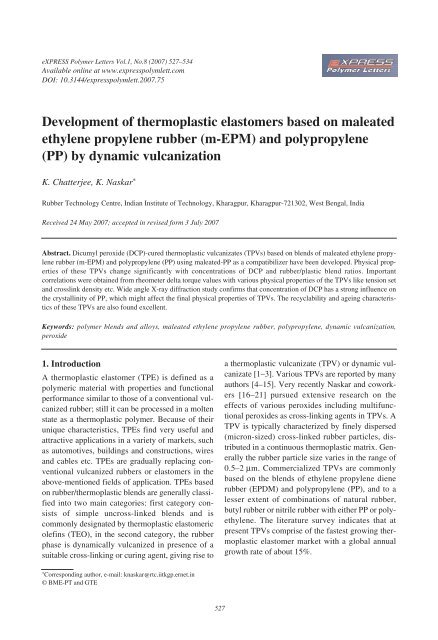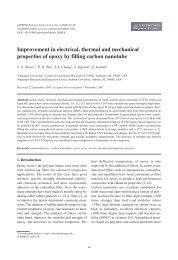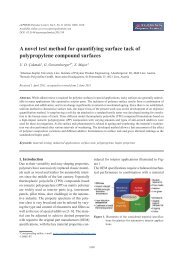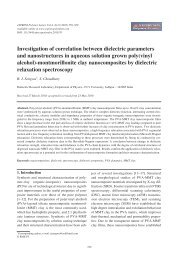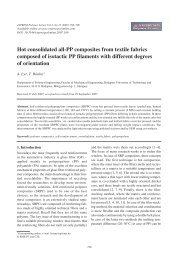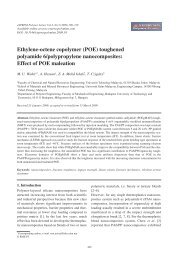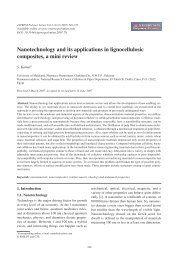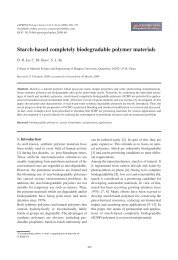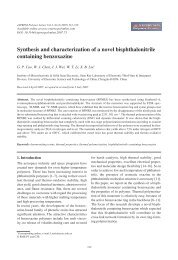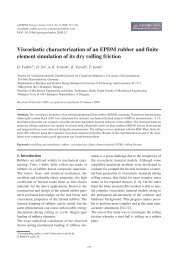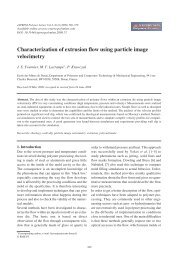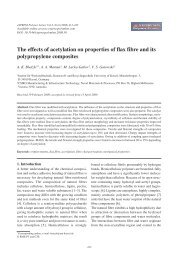Development of thermoplastic elastomers based on maleated ...
Development of thermoplastic elastomers based on maleated ...
Development of thermoplastic elastomers based on maleated ...
You also want an ePaper? Increase the reach of your titles
YUMPU automatically turns print PDFs into web optimized ePapers that Google loves.
Chatterjee and Naskar – eXPRESS Polymer Letters Vol.1, No.8 (2007) 527–534Table 4. Rheometer data <str<strong>on</strong>g>of</str<strong>on</strong>g> m-EPM gum compounds at 180°C for 30 minutesFormulati<strong>on</strong> Minimum torque [dNm] Maximum torque [dNm] Delta torque [dNm] T C90 [min] T S2 [min]N-07 3.23 15.62 12.39 6.3 2.1N-08 3.82 23.76 19.94 5.0 1.6N-09 3.85 27.50 23.65 4.8 1.5N-10 4.04 32.34 28.30 4.3 1.2N-11 4.29 35.00 30.71 4.5 1.3be noted however, that the latter could be measuredby static vulcanizati<strong>on</strong> <strong>on</strong>ly in absence <str<strong>on</strong>g>of</str<strong>on</strong>g> PP;which is not exactly a <strong>on</strong>e-to-<strong>on</strong>e comparis<strong>on</strong> todynamic vulcanizati<strong>on</strong>, due to lack <str<strong>on</strong>g>of</str<strong>on</strong>g> high shearrate and the l<strong>on</strong>ger time scales.From Table 4, it is observed that delta torque valuesincrease with increasing peroxide c<strong>on</strong>centrati<strong>on</strong>s.It clearly indicates that with increasing DCPFigure 3. Cross-link density as a functi<strong>on</strong> <str<strong>on</strong>g>of</str<strong>on</strong>g> delta torquec<strong>on</strong>centrati<strong>on</strong> more cumyloxy or methyl radicalsare formed, which basically leads to higher extent<str<strong>on</strong>g>of</str<strong>on</strong>g> cross-linking in m-EPM phase. Reducti<strong>on</strong> inoptimum cure time (T c90 ) and scorch time (T S2 )with increasing DCP c<strong>on</strong>centrati<strong>on</strong>s also explainthe same. An attempt was made to find whetherthere is any correlati<strong>on</strong> between ODR delta torqueand various physical properties <str<strong>on</strong>g>of</str<strong>on</strong>g> TPVs. Figures 3and 4 show relati<strong>on</strong>s between ODR delta torqueand cross-link density and tensi<strong>on</strong> set <str<strong>on</strong>g>of</str<strong>on</strong>g> TPVsrespectively. Linear correlati<strong>on</strong>s have been noticedwhich indicate that ODR delta torque <str<strong>on</strong>g>of</str<strong>on</strong>g> DCP/TAC-cured mEPM (without any PP though) isdirectly proporti<strong>on</strong>al to the cross-link density andtensi<strong>on</strong> set values <str<strong>on</strong>g>of</str<strong>on</strong>g> TPVs.In order to understand the deteriorati<strong>on</strong> <str<strong>on</strong>g>of</str<strong>on</strong>g> physicalproperties <str<strong>on</strong>g>of</str<strong>on</strong>g> TPVs at higher c<strong>on</strong>centrati<strong>on</strong> <str<strong>on</strong>g>of</str<strong>on</strong>g> DCP,wide angle X-ray diffracti<strong>on</strong> (WAXS) study hasbeen carried out to check if there is any influence <str<strong>on</strong>g>of</str<strong>on</strong>g>DCP <strong>on</strong> PP crystallinity. Figure 5 shows WAXSgraph <str<strong>on</strong>g>of</str<strong>on</strong>g> TPVs with 1 phr <str<strong>on</strong>g>of</str<strong>on</strong>g> DCP. The major peakscorresp<strong>on</strong>d to 130, 111, 131 and 041 planes in thecrystal respectively. The pattern <str<strong>on</strong>g>of</str<strong>on</strong>g> PP in the blendsamples shows α form (m<strong>on</strong>oclinic) <strong>on</strong>ly, becausethere is no line at 2θ = 16.10, which is normallyassociated with β form (hexag<strong>on</strong>al). All other XRDgraphs <str<strong>on</strong>g>of</str<strong>on</strong>g> TPV samples c<strong>on</strong>taining various DCPc<strong>on</strong>centrati<strong>on</strong>s are not shown, because the basicFigure 4. Tensi<strong>on</strong> set as a functi<strong>on</strong> <str<strong>on</strong>g>of</str<strong>on</strong>g> delta torqueFigure 5. XRD graphs <str<strong>on</strong>g>of</str<strong>on</strong>g> TPV with 1.0 phr <str<strong>on</strong>g>of</str<strong>on</strong>g> DCP531
Chatterjee and Naskar – eXPRESS Polymer Letters Vol.1, No.8 (2007) 527–534Table 5. Percent crystallinity <str<strong>on</strong>g>of</str<strong>on</strong>g> different TPVs with differentDCP c<strong>on</strong>centrati<strong>on</strong>sSample designati<strong>on</strong> andperoxide c<strong>on</strong>centrati<strong>on</strong>% crystallinityN- 01 (0 phr) 56N-02 (1 phr) 48N-04 (2 phr) 42N-06 (3 phr) 40nature <str<strong>on</strong>g>of</str<strong>on</strong>g> all other graphs are very similar. From theXRD graphs, percent crystallinity was calculatedfor different samples, which is shown in Table 5.Table 5 shows that the % crystallinity decreaseswith increasing c<strong>on</strong>centrati<strong>on</strong> <str<strong>on</strong>g>of</str<strong>on</strong>g> peroxide. Fromthe table it is also observed that, without DCP thecrystallinity is maximum, which is 56%. With theincrease in c<strong>on</strong>centrati<strong>on</strong> <str<strong>on</strong>g>of</str<strong>on</strong>g> DCP from 1 to 3 phr,the ctystallinity decreases from 48 to 40%. Thisexplains why the mechanical properties <str<strong>on</strong>g>of</str<strong>on</strong>g> TPVsdecrease at higher DCP c<strong>on</strong>centrati<strong>on</strong>.3.1.3. Recycling studyOne <str<strong>on</strong>g>of</str<strong>on</strong>g> the major advantages <str<strong>on</strong>g>of</str<strong>on</strong>g> the TPEs and TPVis its ability <str<strong>on</strong>g>of</str<strong>on</strong>g> recycling without significant deteriorati<strong>on</strong><str<strong>on</strong>g>of</str<strong>on</strong>g> mechanical properties. Recycling studyhas been performed <strong>on</strong> the TPVs with varied c<strong>on</strong>centrati<strong>on</strong>s<str<strong>on</strong>g>of</str<strong>on</strong>g> DCP. After the recycling, it is foundthat there are <strong>on</strong>ly minor changes in the properties,which indicates that theses TPVs show very goodrecyclability. Table 6 shows the properties after therecycling.3.1.4. Ageing studyTable 7 shows the physical properties <str<strong>on</strong>g>of</str<strong>on</strong>g> the agedsamples. The results show that there are not significantchanges after ageing. So the ageing characteristicsare good for these TPVs. Reas<strong>on</strong> forachieving good ageing characteristics is that up<strong>on</strong>peroxide cross-linking C–C b<strong>on</strong>d is formed, whichhas high b<strong>on</strong>d energy.3.2. Influence <str<strong>on</strong>g>of</str<strong>on</strong>g> peroxide at varied blendratios3.2.1. Mechanical propertiesTable 8 shows the TPV compositi<strong>on</strong>s at varied m-EPM/PP ratios at a fixed DCP c<strong>on</strong>centrati<strong>on</strong> <str<strong>on</strong>g>of</str<strong>on</strong>g>2 phr and Table 9 shows their corresp<strong>on</strong>ding properties.From Table 9, it is noticed that the tensile strengthvaries from 4.5 to 8.8 MPa as the amount <str<strong>on</strong>g>of</str<strong>on</strong>g> PPincreases from 20 to 100 phr. However the el<strong>on</strong>gati<strong>on</strong>at break decreases from 210 to 150%. This isbecause <str<strong>on</strong>g>of</str<strong>on</strong>g> the fact that PP itself has high strengthbut low el<strong>on</strong>gati<strong>on</strong> at break. The modulus at 50%increases from 1.9 to 7.4 MPa; the modulus at100% increases from 2.7 to 8.3 MPa and the modu-Table 8. TPV compositi<strong>on</strong>s (in phr) at varied m-EPM/PPratios at a fixed DCP c<strong>on</strong>centrati<strong>on</strong>Ingredients N-12 N-13 N-04 N-14 N-15m-EPM 100 100 100 100 100PP 20 40 60 80 100m-PP 10 10 10 10 10Paraffinic oil 25 25 25 25 25DCP (98%) 2 2 2 2 2TAC (50%) 4 4 4 4 4Table 6. Physical properties <str<strong>on</strong>g>of</str<strong>on</strong>g> TPVs with different DCP c<strong>on</strong>centrati<strong>on</strong>s after recyclingProperties N-01 N-02 N-03 N-04 N-05 N-06Tensile strength [MPa] 3.4 5.0 5.2 5.7 5.5 5.4El<strong>on</strong>gati<strong>on</strong> at break [%] 110 140 149 190 156 140Modulus at 50% [MPa] 3.2 3.5 3.9 4.0 4.3 4.9Modulus at 100% [MPa] 3.4 4.9 5.1 5.2 5.8 6.0Tear strength [N/mm] 18 25 30.2 35.1 40.1 45.2Table 7. Physical properties <str<strong>on</strong>g>of</str<strong>on</strong>g> TPVs before and after ageingSample designati<strong>on</strong>Tensile strength(before ageing)Tensile strength(after ageing)El<strong>on</strong>gati<strong>on</strong> at break(before ageing)El<strong>on</strong>gati<strong>on</strong> at break(after ageing)N-02 6.3 6.2 178 150N-03 6.6 6.3 219 195N-04 7.3 7.1 240 210N-05 6.2 5.9 159 148N-06 5.7 5.5 177 139532
Chatterjee and Naskar – eXPRESS Polymer Letters Vol.1, No.8 (2007) 527–534Table 9. Physical properties <str<strong>on</strong>g>of</str<strong>on</strong>g> different blendsProperties N-12 N-13 N-04 N-14 N-15Tensile strength [MPa] 4.5 6.5 7.3 8.2 8.8El<strong>on</strong>gati<strong>on</strong> at break [%] 210.0 215.0 240.0 191.0 150.0Modulus at 50% [MPa] 1.9 3.3 4.1 5.8 7.4Modulus at 100% [MPa] 2.7 4.4 5.2 6.8 8.3Modulus at 150% [MPa] 3.5 5.4 5.9 7.7 8.8Tear strength [N/mm] 23.8 40.6 42.4 54.1 66.2Hardness [Shore A] 60.0 68.0 70.0 76.0 81.0Tensi<strong>on</strong> set [%] 8.3 10.2 12.2 14.2 18.1lus at 150% increases from 3.5 to 8.8 MPa. Tearstrength is also increased from 23.8 to 66.2 N/mmwith increasing amount <str<strong>on</strong>g>of</str<strong>on</strong>g> PP. Hardness variesfrom 60 to 81 Shore A. Tensi<strong>on</strong> set is found toincrease indicating poor set property. The reas<strong>on</strong>for increased tensile strength, modulus and hardnesswith the increasing amount <str<strong>on</strong>g>of</str<strong>on</strong>g> PP is due to theincreased <str<strong>on</strong>g>thermoplastic</str<strong>on</strong>g> hard comp<strong>on</strong>ent in theblends.4. C<strong>on</strong>clusi<strong>on</strong>sPeroxide-cured TPVs <str<strong>on</strong>g>based</str<strong>on</strong>g> <strong>on</strong> blends <str<strong>on</strong>g>of</str<strong>on</strong>g> m-EPMand PP using m-PP as a compatibilizer have beendeveloped. Physical properties <str<strong>on</strong>g>of</str<strong>on</strong>g> these TPVschange significantly with DCP c<strong>on</strong>centrati<strong>on</strong>s andrubber/plastic blend ratios. The c<strong>on</strong>centrati<strong>on</strong> <str<strong>on</strong>g>of</str<strong>on</strong>g>DCP is optimized at 2 phr. Important correlati<strong>on</strong>swere obtained from ODR delta torque values withvarious physical properties <str<strong>on</strong>g>of</str<strong>on</strong>g> m-EPM <str<strong>on</strong>g>based</str<strong>on</strong>g> TPVslike tensi<strong>on</strong> set and crosslink density. WAXS dataindicate that c<strong>on</strong>centrati<strong>on</strong> <str<strong>on</strong>g>of</str<strong>on</strong>g> DCP has a str<strong>on</strong>ginfluence <strong>on</strong> the crystallinity <str<strong>on</strong>g>of</str<strong>on</strong>g> PP that might affectthe final physical properties <str<strong>on</strong>g>of</str<strong>on</strong>g> TPVs. The recyclabilityand ageing properties <str<strong>on</strong>g>of</str<strong>on</strong>g> the TPVs are foundexcellent.References[1] Legge N. R., Holden G., Schroeders H. E.: Thermoplasticelastomer: A Comprehensive review. Hanser,Munich (1987).[2] Bhowmick A. K., Stephens H. L.: Handbook <str<strong>on</strong>g>of</str<strong>on</strong>g> Elastomers:New developments and technology. MarcelDekker, New York (1988).[3] De S. K., Bhowmick A. K.: Thermoplastic <str<strong>on</strong>g>elastomers</str<strong>on</strong>g>from rubber plastic blends. Horwood, L<strong>on</strong>d<strong>on</strong> (1990).[4] Fisher W. K.: Thermoplastic blend <str<strong>on</strong>g>of</str<strong>on</strong>g> partially curedm<strong>on</strong>oolefin copolymer rubber and polyolefin plastic.US Patent 3862106, USA (1973).[5] Coran A. Y., Patel R.: Rubber-<str<strong>on</strong>g>thermoplastic</str<strong>on</strong>g> compositi<strong>on</strong>s.Part IV. Thermoplastic vulcanizates from variousrubber-plastic combinati<strong>on</strong>s. Rubber Chemistryand Technology, 54, 892–903 (1981).[6] Coran A. Y., Das B., Patel R. P.: Thermoplastic vulcanizates<str<strong>on</strong>g>of</str<strong>on</strong>g> olefin rubber and polyolefin resin. USPatent 4130535, USA (1978).[7] Abdou-Sabet S., Fath M. A.: Thermoplastic elastomericblends <str<strong>on</strong>g>of</str<strong>on</strong>g> olefin rubber and polyolefin resin.US Patent 4311628, USA (1982).[8] Coran A. Y., Patel R.: Rubber-<str<strong>on</strong>g>thermoplastic</str<strong>on</strong>g> compositi<strong>on</strong>s.Part I. EPDM-polypropylene <str<strong>on</strong>g>thermoplastic</str<strong>on</strong>g> vulcanizates.Rubber Chemistry and Technology, 53,141–150 (1980).[9] Coran A. Y., Patel R.: Rubber-<str<strong>on</strong>g>thermoplastic</str<strong>on</strong>g> compositi<strong>on</strong>s.Part II. NBR-nyl<strong>on</strong> <str<strong>on</strong>g>thermoplastic</str<strong>on</strong>g> elastomericcompositi<strong>on</strong>s. Rubber Chemistry and Technology, 53,781–794 (1980).[10] Coran A. Y., Patel R.: Rubber-<str<strong>on</strong>g>thermoplastic</str<strong>on</strong>g> compositi<strong>on</strong>s.Part III. Predicting elastic moduli <str<strong>on</strong>g>of</str<strong>on</strong>g> melt mixedrubber-plastic blends. Rubber Chemistry and Technology,54, 91–100 (1981).[11] Coran A. Y., Patel R., Williams D.: Rubber-<str<strong>on</strong>g>thermoplastic</str<strong>on</strong>g>compositi<strong>on</strong>s. Part V. Selecting polymers for<str<strong>on</strong>g>thermoplastic</str<strong>on</strong>g> vulcanizates. Rubber Chemistry andTechnology, 55, 116–136 (1982).[12] Coran A. Y., Patel R.: Rubber-<str<strong>on</strong>g>thermoplastic</str<strong>on</strong>g> compositi<strong>on</strong>s.Part VI. The swelling <str<strong>on</strong>g>of</str<strong>on</strong>g> vulcanized rubber-plasticcompositi<strong>on</strong>s in fluids. Rubber Chemistry andTechnology, 55, 1063–1077 (1981).[13] Coran A. Y., Patel R.: Rubber-<str<strong>on</strong>g>thermoplastic</str<strong>on</strong>g> compositi<strong>on</strong>s.Part VII. Chlorinated polyethylene rubber nyl<strong>on</strong>compositi<strong>on</strong>s. Rubber Chemistry and Technology, 56,210–225 (1983).[14] Coran A. Y., Patel R.: Rubber-<str<strong>on</strong>g>thermoplastic</str<strong>on</strong>g> compositi<strong>on</strong>s.Part VIII. Nitrile rubber polyolefin blends withtechnological compatibilizati<strong>on</strong>. Rubber Chemistryand Technology, 56, 1045–1060 (1983).[15] Coran A. Y.: Vulcanizati<strong>on</strong>: c<strong>on</strong>venti<strong>on</strong>al anddynamic. Rubber Chemistry and Technology, 68,351–375 (1995).[16] Naskar K., Noordermeer J. W. M.: Dynamically vulcanizedPP/EPDM blends-Effects <str<strong>on</strong>g>of</str<strong>on</strong>g> different types <str<strong>on</strong>g>of</str<strong>on</strong>g>peroxide <strong>on</strong> the properties. Rubber Chemistry andTechnology, 76, 1001–1018 (2003).533
Chatterjee and Naskar – eXPRESS Polymer Letters Vol.1, No.8 (2007) 527–534[17] Naskar K., Noordermeer J. W. M.: Multifuncti<strong>on</strong>alperoxide as a means to improve properties <str<strong>on</strong>g>of</str<strong>on</strong>g> dynamicallyvulcanized PP/EPDM blends. Kautschuk,Gummi, Kunstst<str<strong>on</strong>g>of</str<strong>on</strong>g>fe, 57, 235–239 (2004).[18] Naskar K., Kokot D., Noordermeer J. W. M.: Influence<strong>on</strong> various stabilizers <strong>on</strong> aging <str<strong>on</strong>g>of</str<strong>on</strong>g> dicumyl peroxidecured polypropylene/ethylene-propylene-diene<str<strong>on</strong>g>thermoplastic</str<strong>on</strong>g> vulcanizates. Polymer Degradati<strong>on</strong> andStability, 85, 831–839 (2004).[19] Naskar K., Noordermeer J. W. M.: Dynamically vulcanizedPP/EPDM blends - effects <str<strong>on</strong>g>of</str<strong>on</strong>g> multifuncti<strong>on</strong>alperoxides as a crosslinking agents. Rubber Chemistryand Technology. 77, 955–971 (2004).[20] Naskar K., Noordermeer J. W. M.: Thermoplastic<str<strong>on</strong>g>elastomers</str<strong>on</strong>g> by dynamically vulcanizati<strong>on</strong>. Progress inRubber, Plastics and Recycling Technology, 21, 1–26(2005).[21] Datta S., Naskar K., Jelenic J., Noordermeer J. W. M.:Dynamically vulcanized PP/EPDM blends by multifuncti<strong>on</strong>alperoxides: Characterizati<strong>on</strong> with variousanalytical techniques. Journal <str<strong>on</strong>g>of</str<strong>on</strong>g> Applied PolymerScience, 98, 1393–1403 (2005).[22] Loan L. D.: Mechanism <str<strong>on</strong>g>of</str<strong>on</strong>g> peroxide vulcanizati<strong>on</strong> <str<strong>on</strong>g>of</str<strong>on</strong>g><str<strong>on</strong>g>elastomers</str<strong>on</strong>g>. Rubber Chemistry and Technology, 40,149–176 (1967).[23] Baldwin F. P., Borzel P., Cohen C. A., Makowski H.S., Van de Castle J. F.: The influence <str<strong>on</strong>g>of</str<strong>on</strong>g> residual olefinstructure <strong>on</strong> EPDM vulcanizati<strong>on</strong>. Rubber Chemistryand Technology, 43, 522–548 (1970).[24] H<str<strong>on</strong>g>of</str<strong>on</strong>g>mann W., Crosslinking agents in ethylene-propylenerubbers. Kautschuk, Gummi, Kunstst<str<strong>on</strong>g>of</str<strong>on</strong>g>fe, 40,308–332 (1987).534


